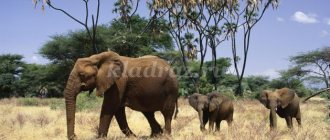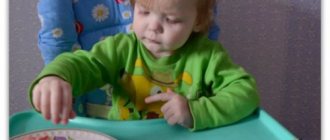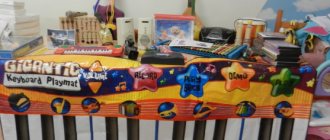Lapbook “Wild Animals”
Zeinib Chenib
Lapbook “Wild Animals”
Didactic manual
Lapbook
«Wild animals»
Author: Chenib Zeinib, teacher of 1st quarter categories
MBDOU No. 5 Kindergarten "Kalinka"
p Enem Republic of Adygea
Description: the didactic manual is intended for preschool children.
Goal: To introduce children to forest animals .
Tasks:
of wild animals and their young in the children's vocabulary .
2. Develop attention and observation.
Dear colleagues, I present to your attention my first lapbook “ Wild Animals ”
, for children of the younger group.
This manual was created with the goal of introducing children to forest animals , teaching them to compare animals by appearance , and naming parts of the animal’s (torso, tail, head, horns, hooves, paws)
.
Find out where animals , what they eat, how they prepare for winter (molting, supplies, housing, to help children remember information. To create the manual, I used a binder with rings so that you can change or add information for children.
When compiling the lapbook, I used pictures from the Internet, some purchased from a bookstore, and some I did myself.
My thematic folder contains the following games:
1 Game “Collect the picture”
(cut pictures)
Develops fine motor skills of the hands, teaches how to correctly assemble an image of an object from individual parts, and consolidates children's knowledge about wild animals .
2. Game “Find my shadow”
Develops logic, thinking and visual memory.
3. Game “Whose traces?”
Develops attention, logic, memory.
4. Reading. Teaches to listen carefully, consolidates children's understanding of wild animals , and develops the ability to retell consistently based on questions.
5. Game “Name the Family”
Teaches children to correctly name
animals and their babies .
6. Poems. Development of auditory memory.
7. Game “Name it correctly”
(affectionately)
. Develop speech. Recognize and call the cubs affectionately.
8. Game “Who lives where”
(home of
wild animals ) .
9. Riddles Development of logical thinking.
10. Game “Tell me”
.
Using the diagram and symbols, children learn to describe any animal .
11. Finger gymnastics. Development of fine motor skills of the hands.
12 Coloring pages. Strengthen your coloring skills.
13 Game "Fourth wheel"
.
In a playful way, develop in children the ability to classify animals .
Lotto: Consolidating children's knowledge about animals , the ability to distinguish and find the right animal .
14. Baby book “In the forest”
Game "Who Lives in the Forest"
To consolidate children's knowledge about the inhabitants of the forest -
animals (hare, fox, bear, wolf, squirrel, elk, wild boar)
.
Form the concept of “
wild animals ” .
Learn to talk about the hare, bear, squirrel and other animals .
15 Game “Find Mom”
. Develop observation, attention and analytical skills.
16. Game “Find a treat”
. Strengthen children's knowledge.
17. Book “How wild animals prepare for winter ”
.
Learn to establish simple connections between seasonal changes in nature and animal .
18. Game “One is many”
Develop children's speech.
19. Game “Who gives what voice?”
The fox barks.
The bear growls.
The wolf howls.
Hedgehog - snorts, etc.
20. Rules of behavior in the forest. Teach children to take care and protect nature.
Foster a caring attitude towards the inhabitants of wildlife .
Thank you for attention!
MAGAZINE Preschooler.RF
Didactic manual lapbook “Wild Animals” for children of the younger group.Relevance: this topic is that creating a “lapbook” will help consolidate and systematize the material studied, and looking at the folder in the future will allow you to quickly refresh your memory of the topics covered.
The teaching aid lapbook “Wild Animals” is an A4 cardboard folder, 4 pages, covered with self-adhesive tape. On the pages of the folder there are various pockets and cards that contain information on the topic.
Main advantages: multifunctional, portable,
the allowance is flat.
The lapbook contains materials about wild animals living in the forest for educational activities with young children. It includes 8 developmental tasks.
Didactic game “Whose tail?”
Purpose of the game: to consolidate knowledge on the topics “Wild Animals”, to consolidate the ability to form possessive adjectives, and to develop fine motor skills.
Equipment: Cardboard cut-out images of animals and tails, in the shape of a clock.
Progress of the game:
The teacher gives the children drawn animal faces, and then one by one shows the drawn tails. Children must name “their” animal and choose a suitable tail for it.
Didactic game “Find whose shadow”
Purpose of the game: learn to find given silhouettes. Consolidating children's knowledge about animals. Development of attention, perseverance, observation.
Equipment: cards with images of animals, cards with images of shadow silhouettes.
Progress of the game:
Children are given cards with given silhouettes. Invites children to look at them. Then the presenter shows one of the cards with the image of an animal and names it. Children must find the desired silhouette among the cards they have. If the child finds the card correctly, he puts the color image on the shadow.
Didactic game "Fourth odd"
Purpose of the game: improving knowledge about wild animals, developing vocabulary, consolidating the concept of “wild animals” in children’s speech.
Equipment: cards with images of animals
Progress of the game:
The child carefully examines the objects shown on the card and names them. After which he names an object that, in his opinion, is superfluous, covers it with a cross and explains his choice.
Didactic game “Collect a picture”
Purpose of the game: to teach children how to correctly assemble an image of an object from individual parts.
Equipment: cards with images of objects, cut-out pictures corresponding to the images on the cards
Progress of the game:
In front of the children on the table are cut-out pictures depicting an object, illustration, drawing, etc. The teacher invites the children to carefully examine and assemble the picture from individual parts. At the end of the task, children are asked to compare the resulting image.
Didactic game with clothespins “Who eats what”
Purpose of the game: to consolidate children’s knowledge of what different wild animals eat; develop thinking, attention; speech, as well as develop fine motor skills.
Equipment: a picture with food and animal faces on clothespins.
Progress of the game:
The child is asked to attach clothespins with animal faces to the circle in such a way as to indicate the correspondence between the animal and the type of food; the teacher asks what the animal is called and what it eats.
Didactic game “Find your mother”
Purpose of the game: to teach children to distinguish animals by appearance and help the cubs find their mother.
Equipment: cards or elements of costumes, masks, medals with images of adult wild animals-mothers, images of their cubs.
Progress of the game:
Children are divided into two groups. Children of the first group receive cards or elements of costumes, masks, medals with images of adult wild mother animals, and children of the second group receive images of their cubs. The children take turns looking for their mother, calling her, showing how happy they are that they found their mother.
| Next > |







